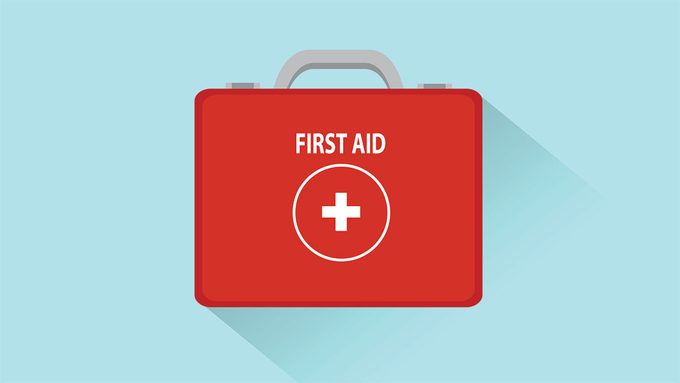First-Aid Refresher: How to Treat Wounds, Fever, Sprains and Breaks
Who couldn’t use a first aid refresher? That’s why went ahead and got expert tips on treating common first-aid issues, so they don’t become big problems.

Who couldn’t use a first aid refresher?
Feel like you need a first aid refresher when it comes to general first aid? Yeah, us too. So, we went back to class with Chrissy Rowan, a registered nurse and president of the Canadian Family Practice Nurses Association. She primed us on tips and tricks for managing three common first-aid issues: wound care, sprains and breaks, and fevers. Consider yourself schooled!
Wound Care first aid refresher
For any injury that happens at home, the first order of business is to clean and dry the wound. For the most part, rinsing with tap water (if it’s been chlorinated) is fine. If you want to, you can use a commercial saline solution, or make your own: Mix one cup (250 mL) of water and one teaspoon (25 mL) of salt, boil, covered, for 15 minutes. Let cool. Clean the wound every 24 hours and change the bandage as little as it takes to keep the wound clean.
Seek medical attention if
• Bleeding has not subsided after 10 to 20 minutes of direct pressure to the area.
• The wound is deep (gaping open, edges not touching, jagged, skin has split open). Get medical attention because it may need to be sutured.
• The wound is infected. Signs of infection can include redness, warmth, swelling, odour, drainage (pus), increased bleeding, a fever and general weakness.
• The wound was caused by a bite. They are dirty and easily infected.
• You have a compromised immune system.
The other thing to consider is whether you’ve had a tetanus shot within the past 10 years, says Rowan. ‘If not, get one within 48 hours of the injury.
Sprains and breaks first aid refresher
Sometimes it’s very straightforward to determine a sprain from a break. “You don’t need an X-ray, as a healthcare provider can usually determine if the injury is a sprain or a fracture by the location of the pain” says Rowan. Even if it’s a muscle sprain or strain, that doesn’t mean you don’t need medical attention. “Soft-tissue injuries can be just as painful as fractures and suffer long-term damage if not appropriately treated,” says Rowan.
Seek medical attention immediately if
• You’re experiencing severe pain and completely unable to use the limb.
• The bone is protruding from the skin, the limb takes on a different shape or your extremities are cold, numb or turning blue.
If you’ve determined that you don’t need immediate medical attention, treat your injury for the first 24 to 48 hours using these four steps, commonly called the RICE method.
Rest Use the limb as little as possible.
Ice Apply ice to the affected area for no more than 20 minutes every hour. Ensure that there is a barrier between the ice and your skin (a tea towel works well).
Compression Wrap the limb in a tensor bandage with medium compression, rewrapping every two to four hours.
Elevation Have the affected area rest at a point higher than the heart.
This four-step process will help reduce inflammation and allow healing to begin. If there’s no improvement within 48 hours, see your healthcare provider.
Fever first aid refresher
“A fever is one of the body’s natural protective mechanisms to defeat a viral or bacterial illness. It means that your body is working to fight infection,” says Rowan. “The best way to take a temperature is under the tongue with your mouth closed.” (Make sure you haven’t had anything to eat or drink within the past 15 minutes.) Under the armpit is also acceptable, as long as the object is tucked tightly under the arm and held close against the body. Rowan mentions that if the thermometer doesn’t have an axillary setting, add one degree when taking your temperature under the armpit. Ear thermometers can be quick, but it’s easy to make a mistake with them.
How to treat:
• Stay hydrated. Eat and drink normally to ensure that you’re getting enough electrolytes.
• Don’t bundle up in warm clothing, and try a cool cloth on your forehead.
• A fever above 40°C is a cause for concern and you should take acetaminophen or ibuprofen to bring the fever down. Don’t use Aspirin to treat fevers, especially for those under the age of 16, as it can cause Reye’s syndrome (swelling in the liver and brain).
Seek medical attention if
• Medication has failed to reduce a fever above 40°C.
• Someone who is 65 or older or has a compromised immune system has a fever over 38.3°C.
• An infant who is younger than three months (no immunizations within the past 24 hours) has a fever above 38°C.




